Bell P-59 Airacomet Video - Historical overview
|
|
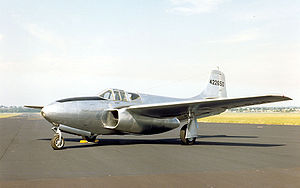
Picture - Bell P-59B Airacomet at the National Museum of the United States Air Force, Dayton, Ohio.
Role: Fighter
Manufacturer: Bell Aircraft
Designed by: Harland M. Poyer
First flight: 1 October 1942
Primary users: United States Army Air Forces
United States Navy
Royal Air Force
Number built: 66
The Bell P-59 Airacomet was the first American jet fighter aircraft, designed and built during World War II. The United States Army Air Forces was not impressed by its performance and cancelled the contract when fewer than half of the aircraft ordered had been produced. Although no P-59s went into combat, it paved the way for another design generation of U.S. turbojet-powered aircraft and was the first turbojet fighter to have its turbojet engine and inlet nacelles integrated within the main fuselage.
Design and development
Major General Henry H. Arnold became aware of the United Kingdom's jet program when he attended a demonstration of the Gloster E.28/39 in April 1941. The subject had been mentioned, but not in depth, as part of the Tizard Mission the previous year. He requested, and was given, the plans for the aircraft's powerplant, the Power Jets W.1, which he took back to the U.S. On 4 September, he offered the U.S. company General Electric a contract to produce an American version of the engine. On the following day, he approached Lawrence Dale Bell, head of Bell Aircraft Corporation, to build a fighter to utilize it. Bell agreed and set to work on producing three prototypes. As a disinformation tactic, the USAAF gave the project the designation P-59A, to suggest it was a development of a completely unrelated Bell XP-59 fighter project that had been canceled. The design was finalized on 9 January 1942, and construction began. In March, long before the prototypes were completed, an order for 13 YP-59A pre-production machines was added to the contract.
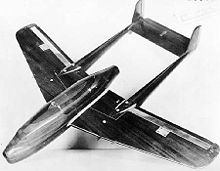
Picture - Bell XP-59 wind tunnel model. Original pusher-propeller design.
On 12 September 1942, the first XP-59A was sent to Muroc Army Air Field (today, Edwards Air Force Base) in California by train for testing, taking seven days to reach Muroc. While being handled on the ground, the aircraft was fitted with a dummy propeller to disguise its true nature. The aircraft first became airborne during high-speed taxiing tests on 1 October with Bell test pilot Robert Stanley at the controls, although the first official flight was made by Col Laurence Craigie the next day. Over the following months, tests on the three XP-59As revealed a multitude of problems including poor engine response and reliability (common shortcomings of all early turbojets), insufficient lateral stability, i.e., in the roll axis, and performance that was far below expectations. Chuck Yeager flew the aircraft and was dissatisfied with the speed, but was amazed at the smooth flying. Nevertheless, even before delivery of the YP-59As in June 1943, the USAAF ordered 80 production machines, designated P-59A Airacomet.
Operational service
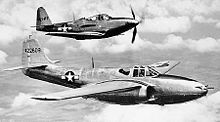
Picture - P-59A (S/N 44-22609, first production -A model) and P-63 (S/N 42-69417) in flight.
The 13 service test YP-59As had a more powerful engine than its predecessor, but the improvement in performance was negligible with only a five mph increase in top speed. One of these aircraft, the third YP-59A (S/n: 42-22611) was supplied to the RAF, becoming RG362/G, in exchange for the first production Gloster Meteor I, EE210/G. British pilots found that the aircraft compared very unfavorably with the jets that they were already flying. (The YP-59A also compared unfavorably to the propeller-driven P-51 Mustang.) Two YP-59A Airacomets (42-108778 and 42-100779) were also delivered to the U.S. Navy where they were evaluated as the YF2L-1 but quickly found completely unsuitable for carrier operations.
Faced with their own ongoing difficulties, eventually, Bell completed 50 production Airacomets, 20 P-59As and 30 P-59Bs. Each was armed with one 37 mm M4 cannon and 44 rounds of ammunition and three .50 cal. machine guns with 200 rounds per gun. The P-59Bs were assigned to the 412th Fighter Group to familiarize AAF pilots with the handling and performance characteristics of jet aircraft. While the P-59 was not a great success, the type did give the USAAF experience with the operation of jet aircraft in preparation for the more advanced types that would shortly become available.
Variants

Picture - P-59A Airacomet with the short-lived red outlined National markings (June 1943 to September 1943).
XP-59 Unrelated piston engine powered pusher propeller design developed from the Bell XP-52. Not built. XP-59A Prototype of the jet engine powered version, 3 built. YP-59A Series of test aircraft, 13 built.
YF2L-1 Two YP-59A delivered to the US Navy for carrier evaluation.
YF2L-1 Two YP-59A delivered to the US Navy for carrier evaluation.
P-59A First production version, 20 built. P-59B Improved P-59A. 80 aircraft ordered but only 30 built, 50 canceled.
Operators
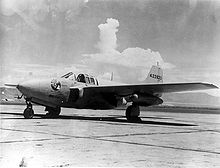
Picture - Bell P-59B Airacomet 3/4 front view of Reluctant Robot.
United Kingdom
Royal Air Force received one aircraft, becoming RG362/G, in exchange for a Gloster Meteor I EE210/G.
United States
United States Army Air Forces
412th Fighter Group
445th Fighter Squadron
United States Navy
Survivors
XP-59A
The original prototype XP-59A is on display the Milestones of Flight Gallery at the National Air and Space Museum in Washington, DC
YP-59
YP-59 is undergoing restoration to flying condition at the Planes of Fame Museum in Chino, California. The aircraft was acquired in 1991.
P-59A
P-59A (44-22614) is on display at the March Field Air Museum in Riverside, California
P-59B
P-59B (42-2633) is on display at Edwards Air Force Base.
P-59B (44-22656) is on display at the Pioneer Museum, Minden, Nebraska.
P-59B (44-2650) is on display at the National Museum of the United States Air Force at Wright-Patterson Air Force Base near Dayton, Ohio. It was obtained from Kirtland Air Force Base in New Mexico in February 1956.
Specifications (P-59A)
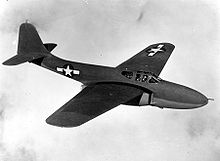
Picture - Bell YP-59A in flight. X and Y aircraft had rounded vertical stabilizers and wingtips while the production A and B models had squared surfaces. The YP-59A can be distinguished from the XP-59A because Ys had nose armament.
General characteristics
Crew: 1
Length: 38 ft 2 in (11.63 m)
Wingspan: 45 ft 6 in (13.87 m)
Height: 12 ft 4 in (3.76 m)
Wing area: 386 sqâft (35.9 m²)
Empty weight: 7,940 lb (3,600 kg)
Max takeoff weight: 12,700 lb (5,760 kg)
Powerplant: 2x General Electric I-A turbojets, 2,000 lbf (8.9 kN) each
Performance
Maximum speed: 413 mph (664 km/h)
Range: 240 mi (386 km)
Service ceiling: 46,200 ft (14,080 m)
Rate of climb: 3,200 ft/min (16,26 m/s)
Armament
1x 37 mm cannon
3x .50 cal (12.7 mm) machine guns
Heinkel He 178
Heinkel He 280
Comparable aircraft
de Havilland Vampire
Gloster E.1/44
Gloster Meteor
P-80 Shooting Star
Messerschmitt Me 262
Nakajima J9Y Kikka
Sukhoi Su-9
Bibliography
"Airacomet......a jet pioneer by Bell". Air International, March 1980, Vol 18 No 3. Bromley, UK:Fine Scroll. ISSN 0306-5634. pp. -139.132
Baugher, Joe. Bell P-59 Airacomet. Retrieved: 26 December 2006.
Carpenter, David M. Flame Powered: The Bell XP-59A Airacomet and the General Electric I-A Engine. Boston: Jet Pioneers of America, 1992. ISBN 0-9633387-0-6.
Donald, David (editor). American Warplanes of World War II. London:Aerospace Publishing, 1995. ISBN 1 874023 72 7.
Green, William. War Planes of the Second World War, Volume Four: Fighters. London: MacDonald & Co. (Publishers) Ltd., 1961 (Sixth impression 1969). ISBN 0-356-01448-7.
Green, William and Gordon Swanborough. WW2 Aircraft Fact Files: US Army Air Force Fighters, Part 2. London: Macdonald and Jane's Publishers Ltd., 1978. ISBN 0-354-01072-7.
United States Air Force Museum booklet. Dayton, Ohio: Air Force Museum Foundation, Wright-Patterson AFB, Ohio, 1975.
Living Warbirds: The best warbirds DVD series.
Source: WikiPedia